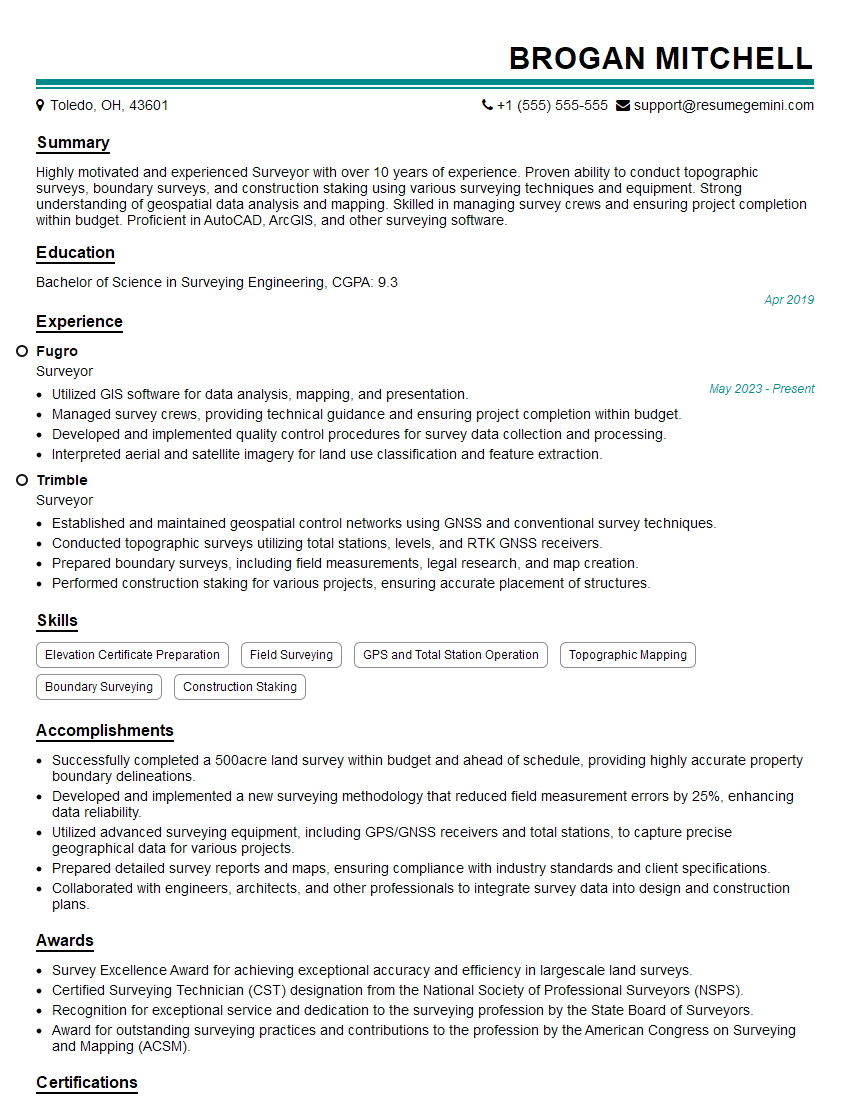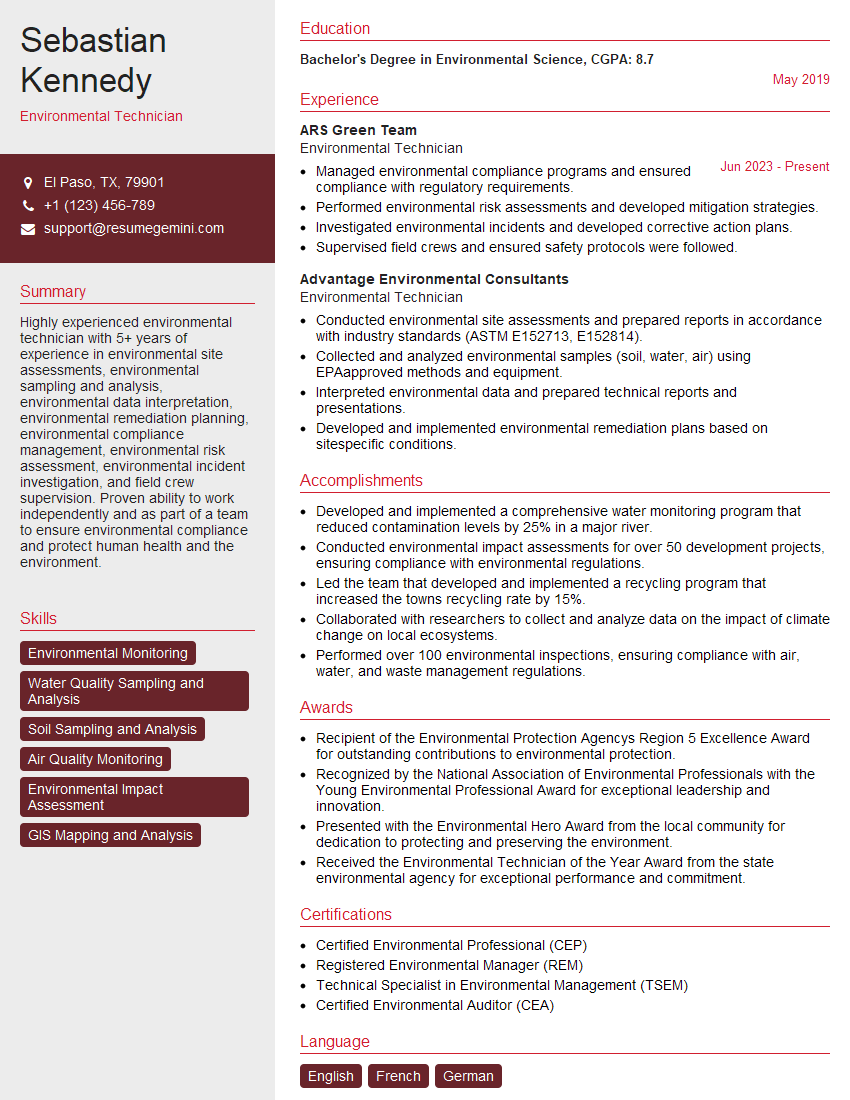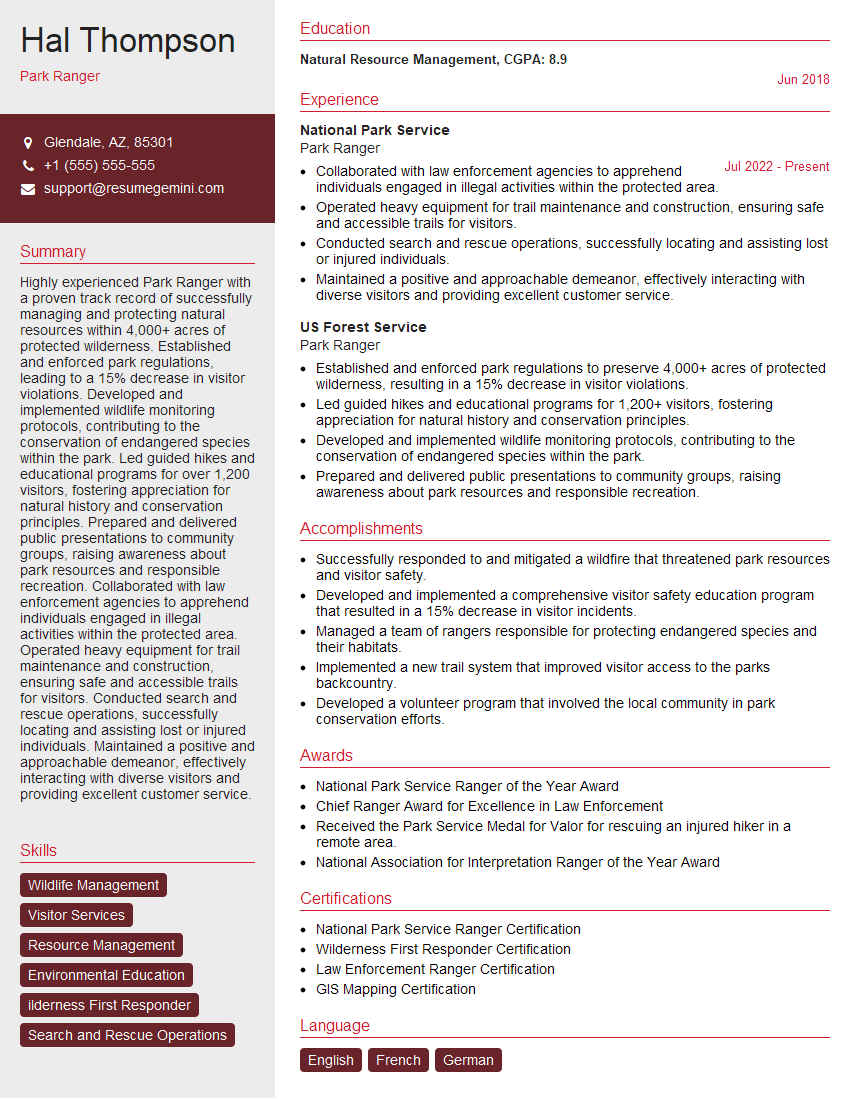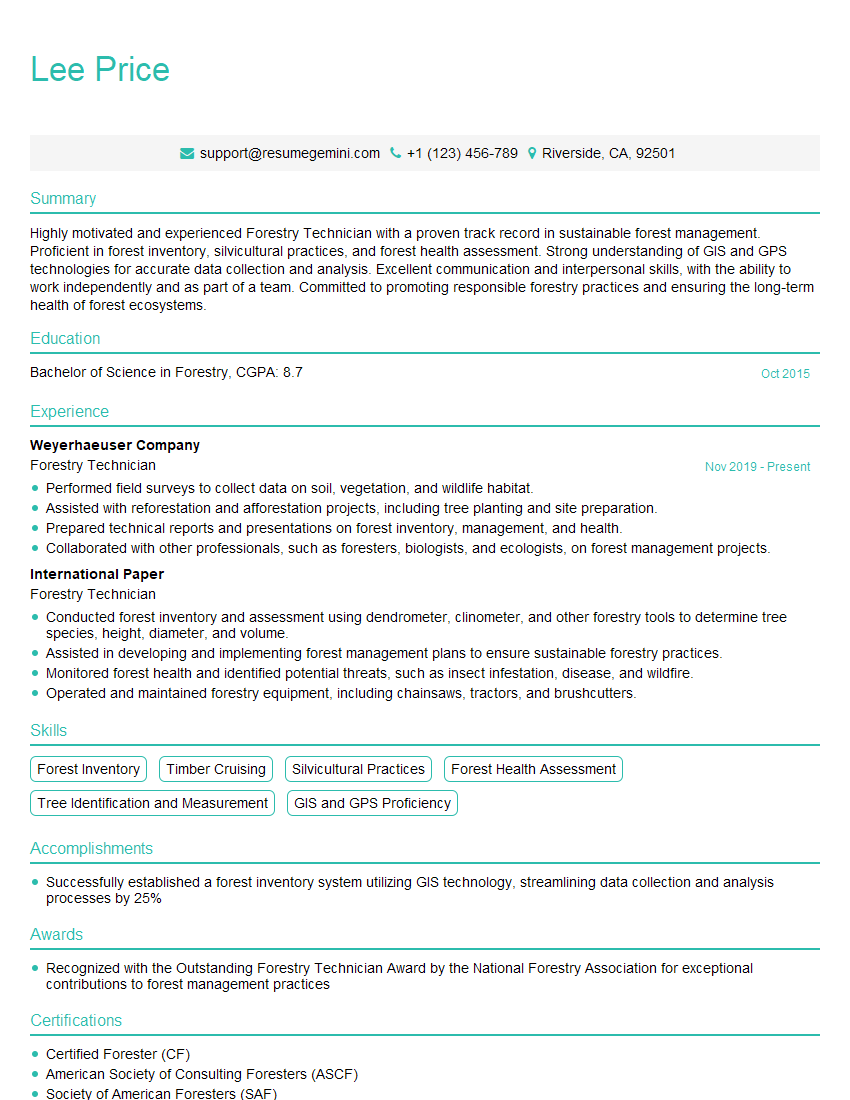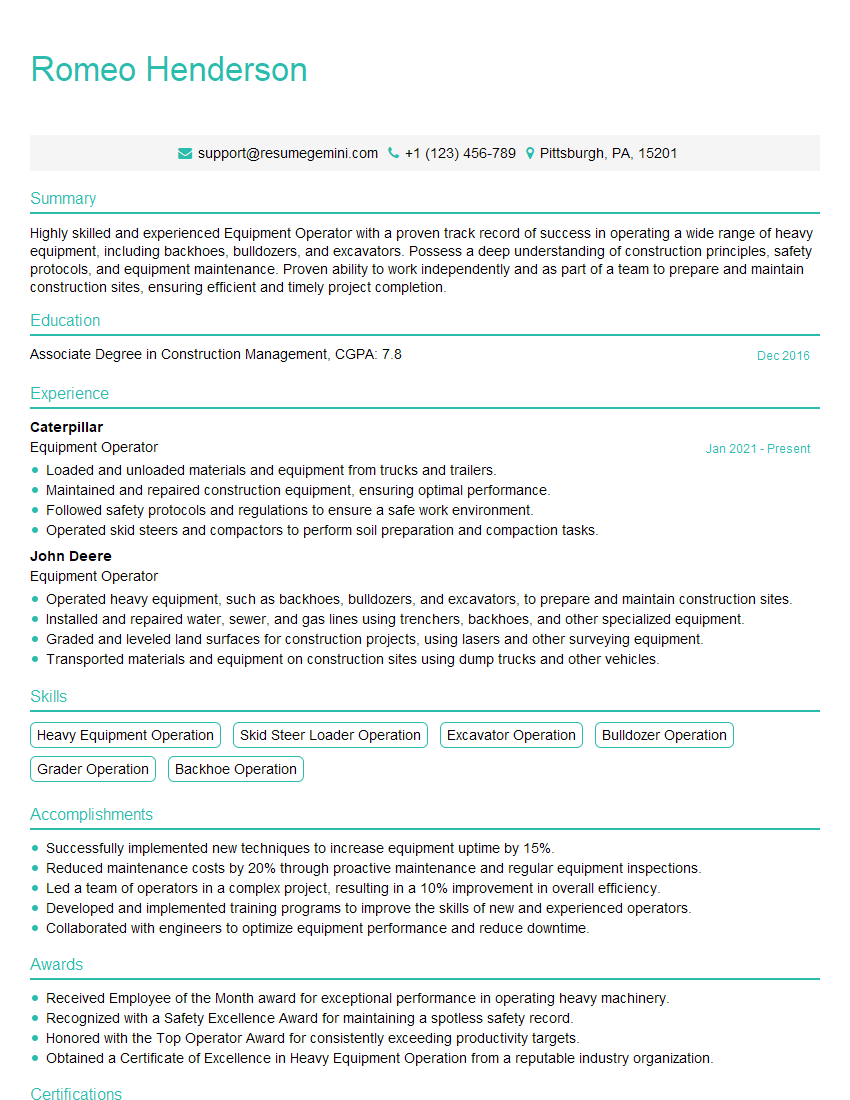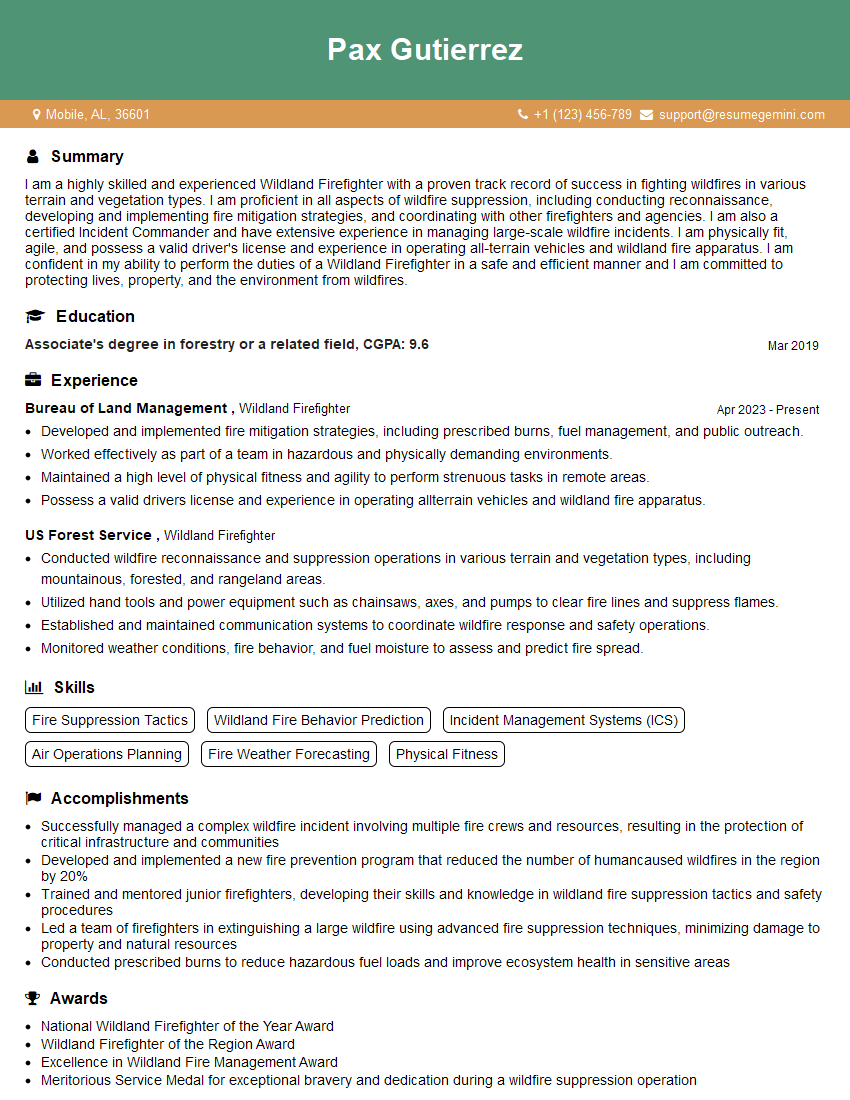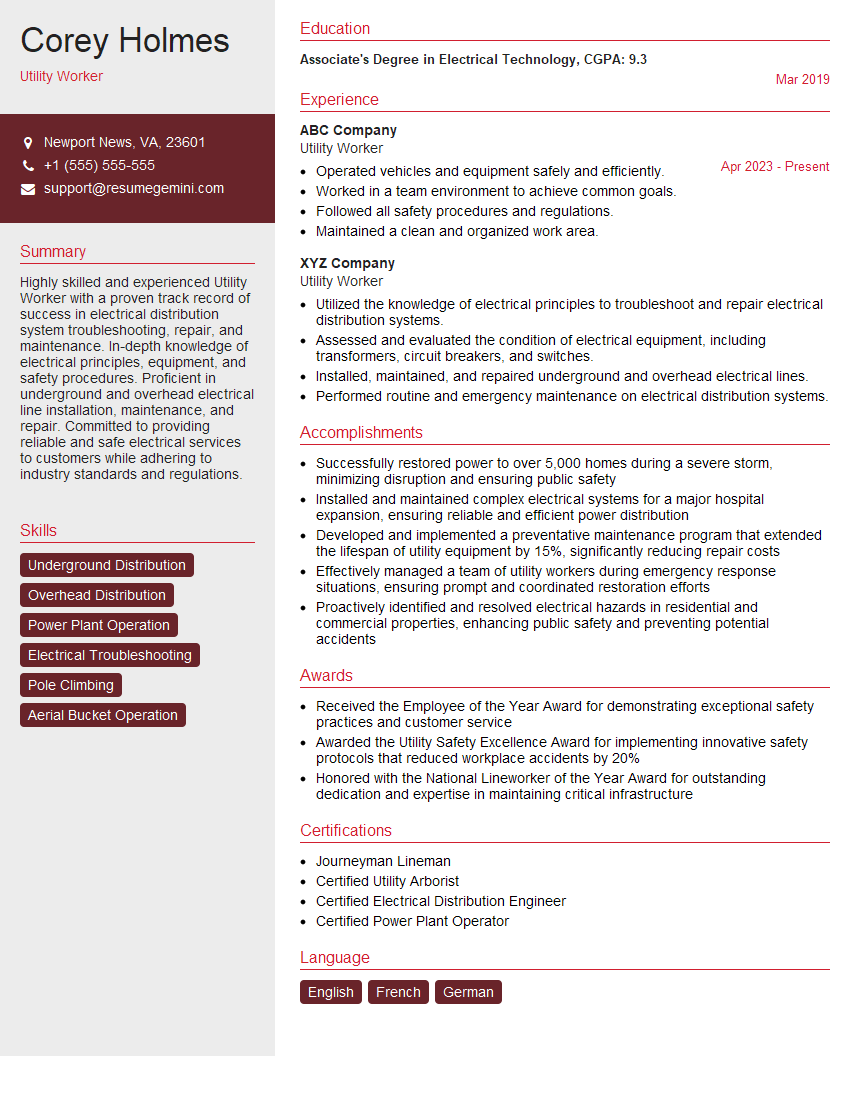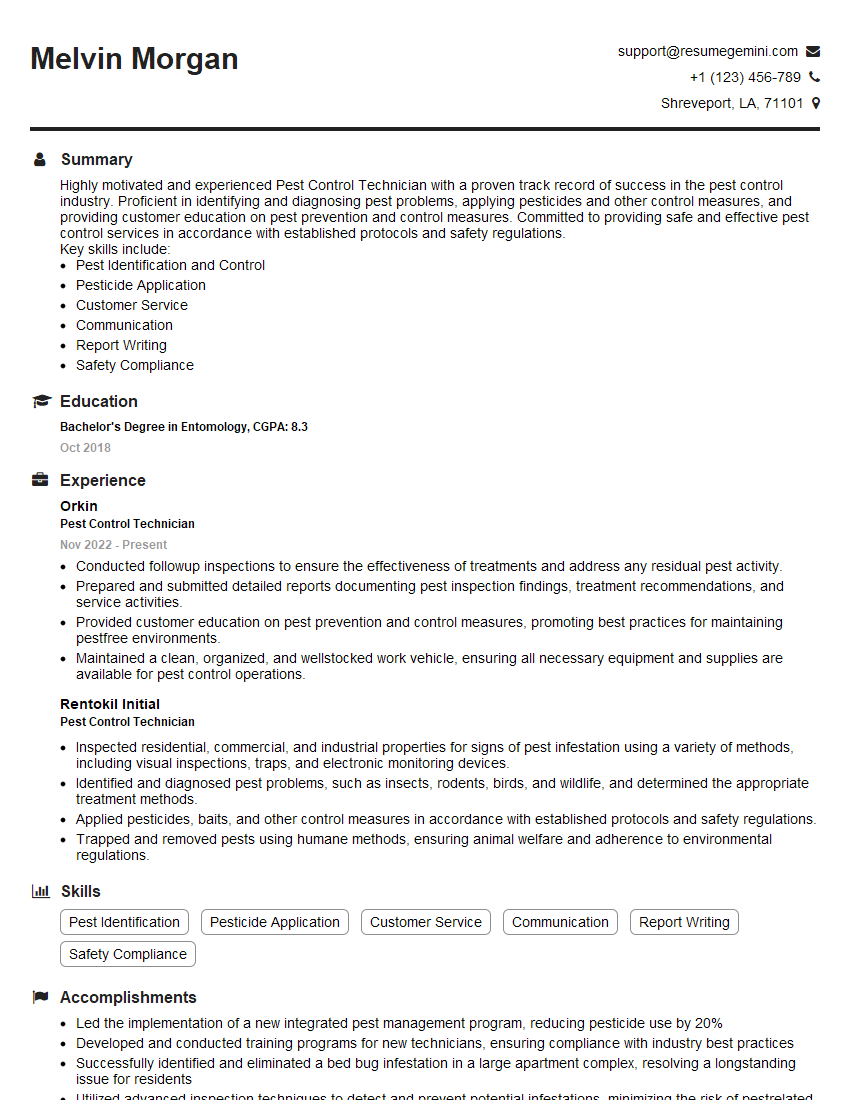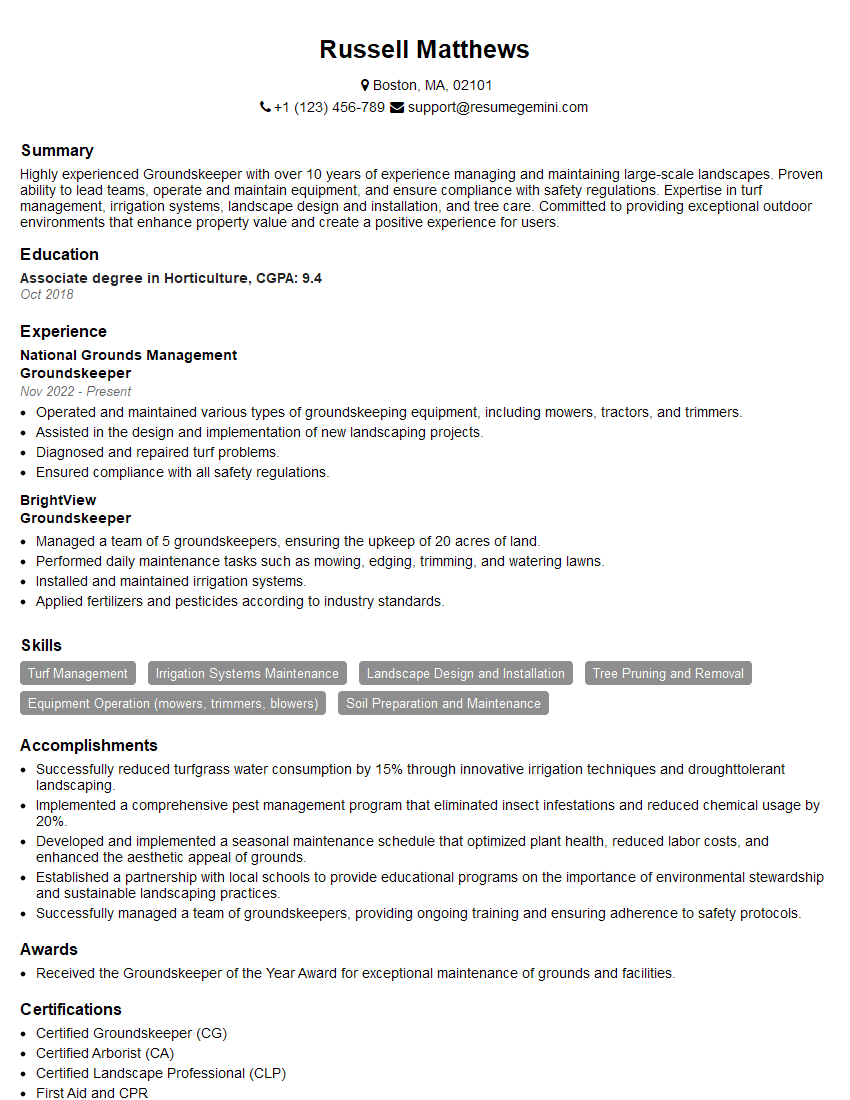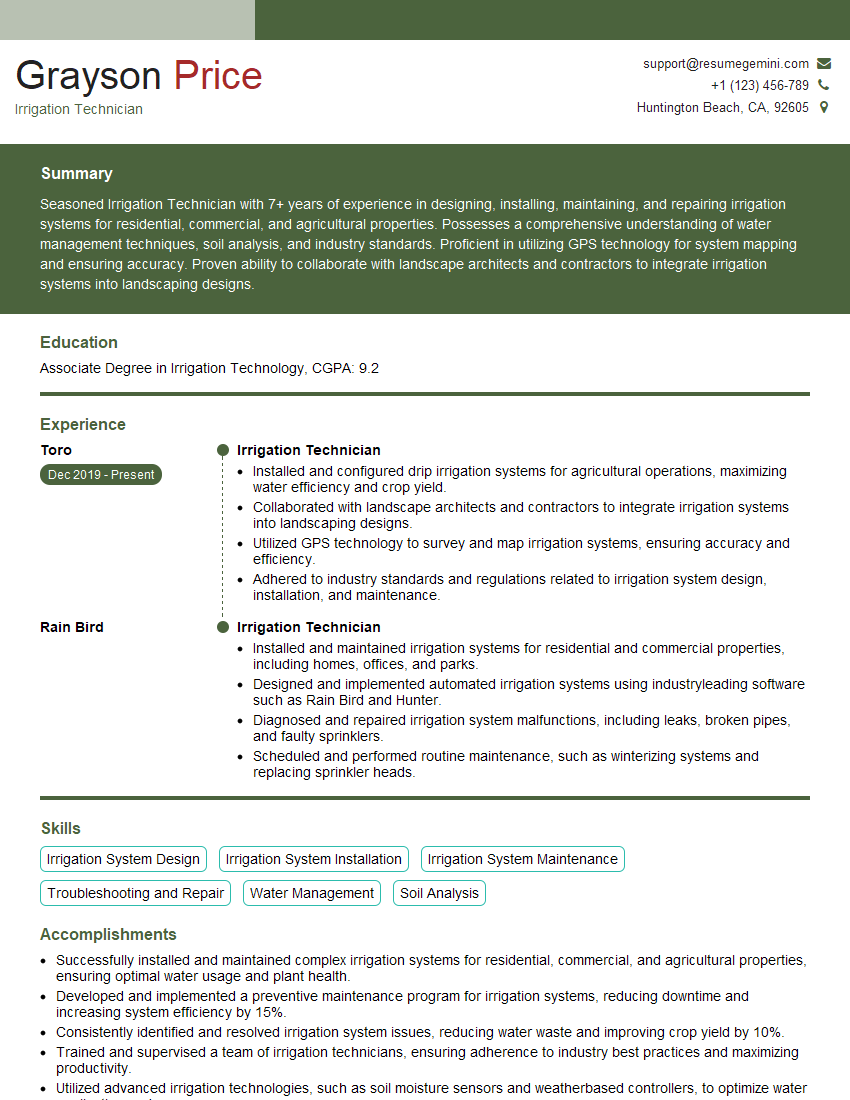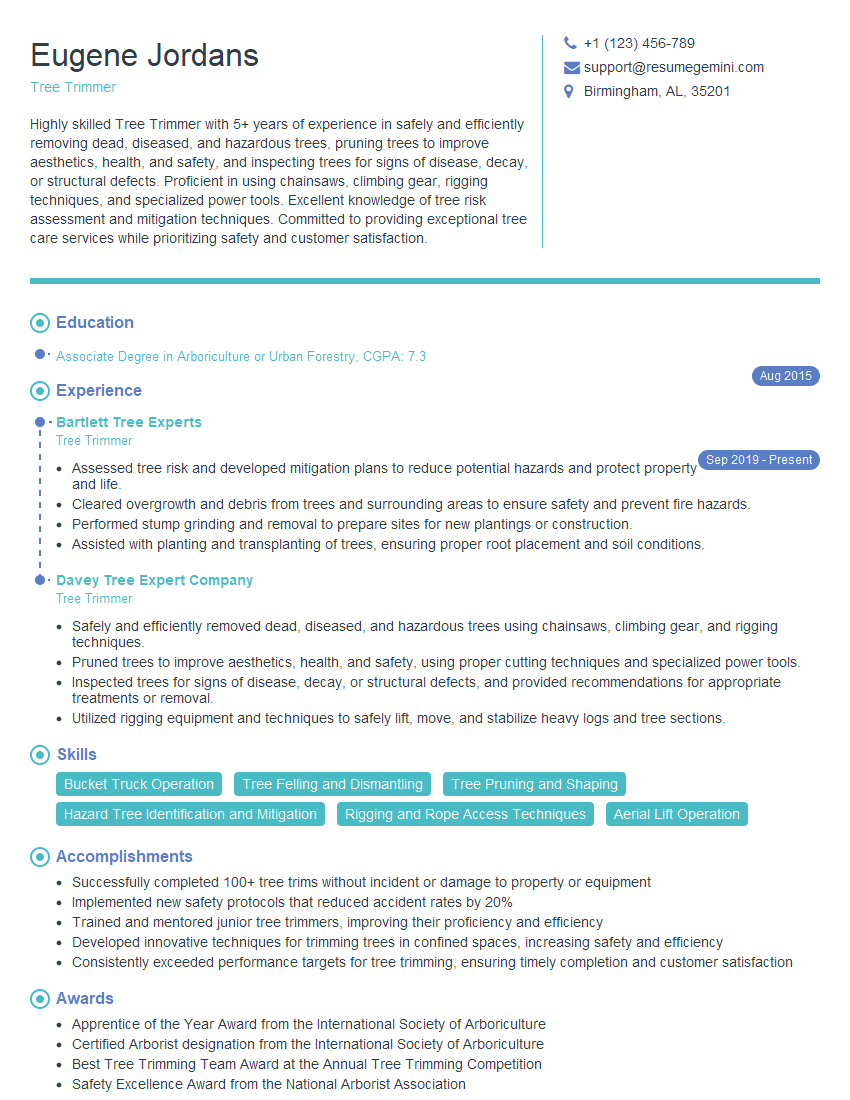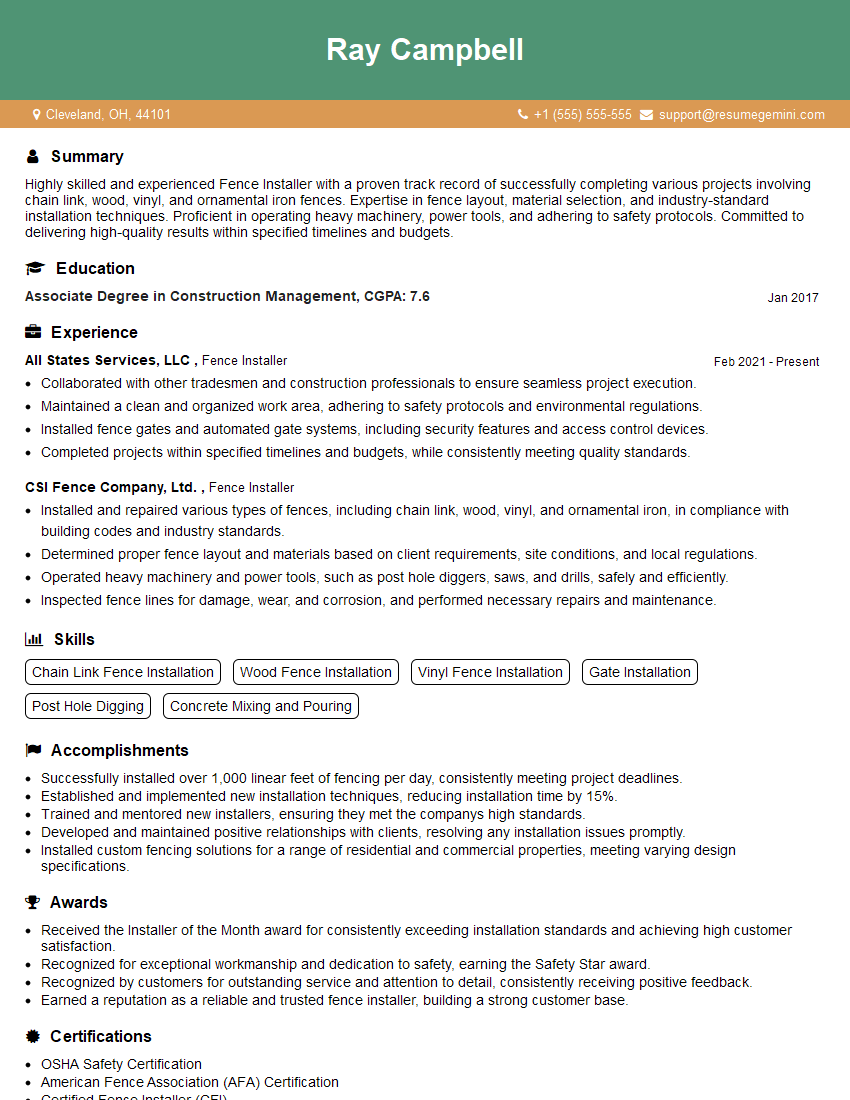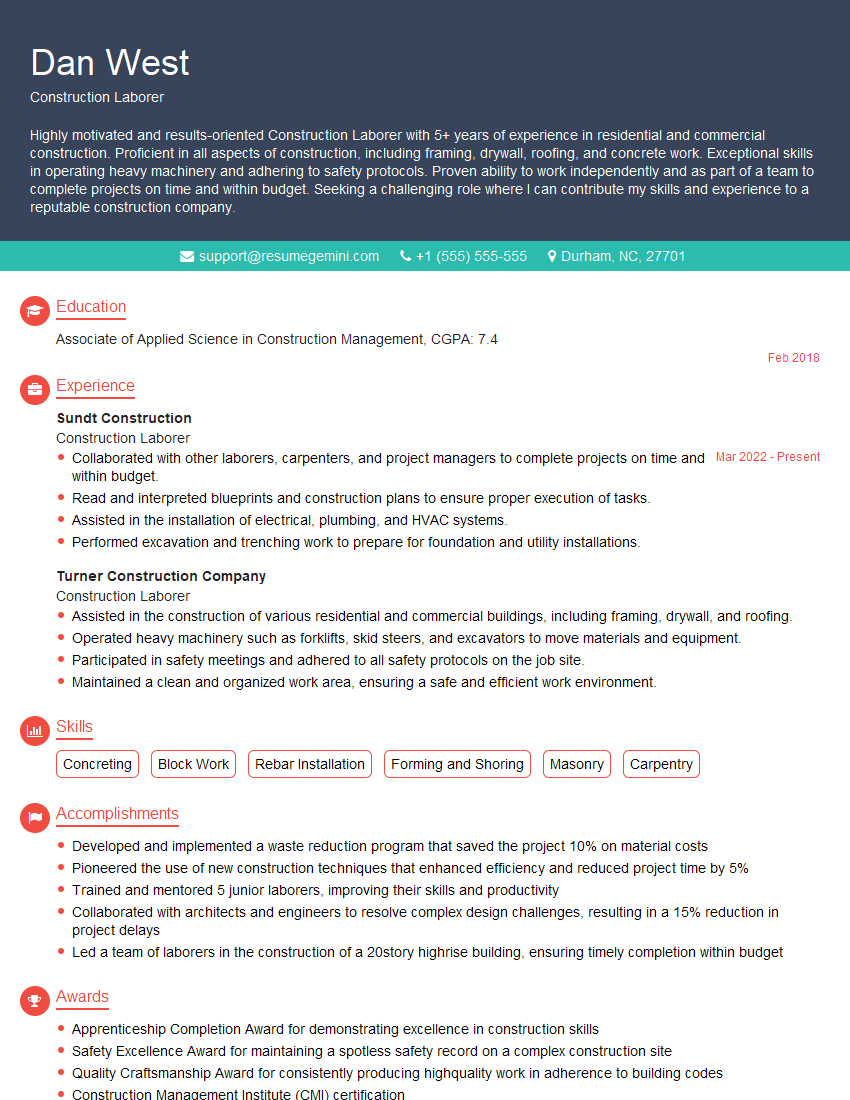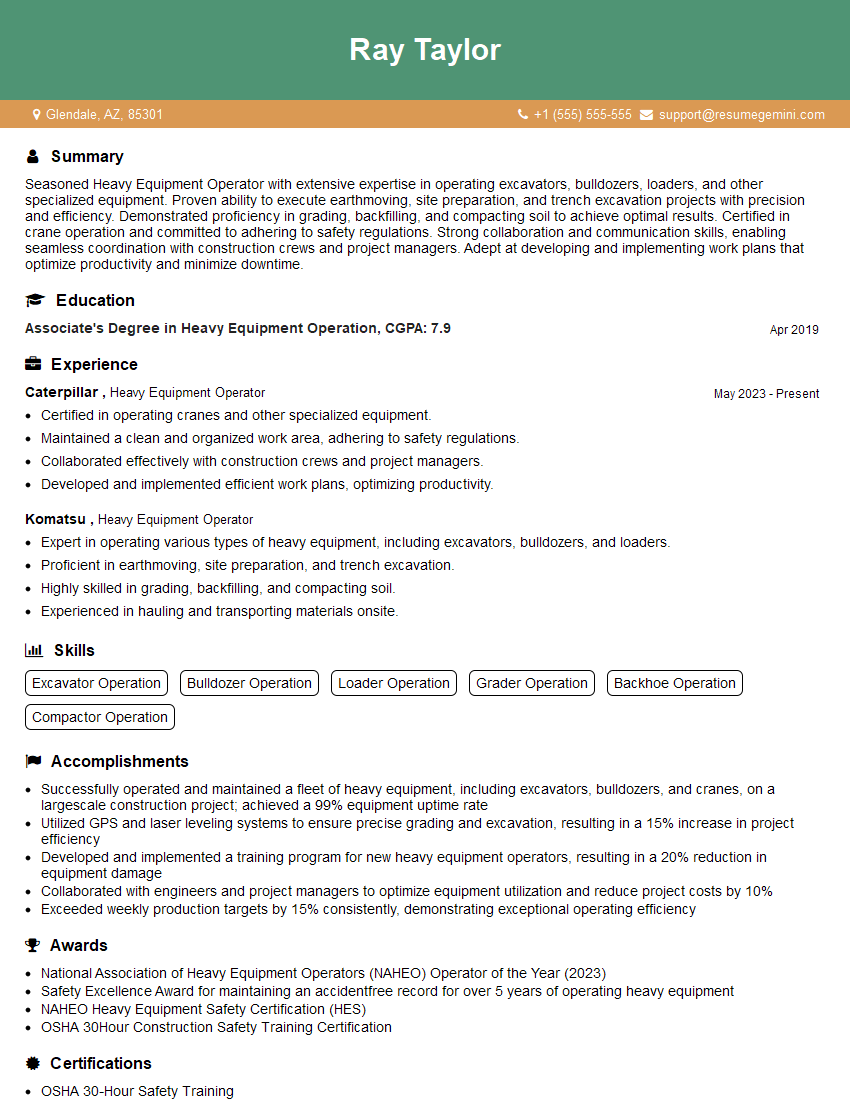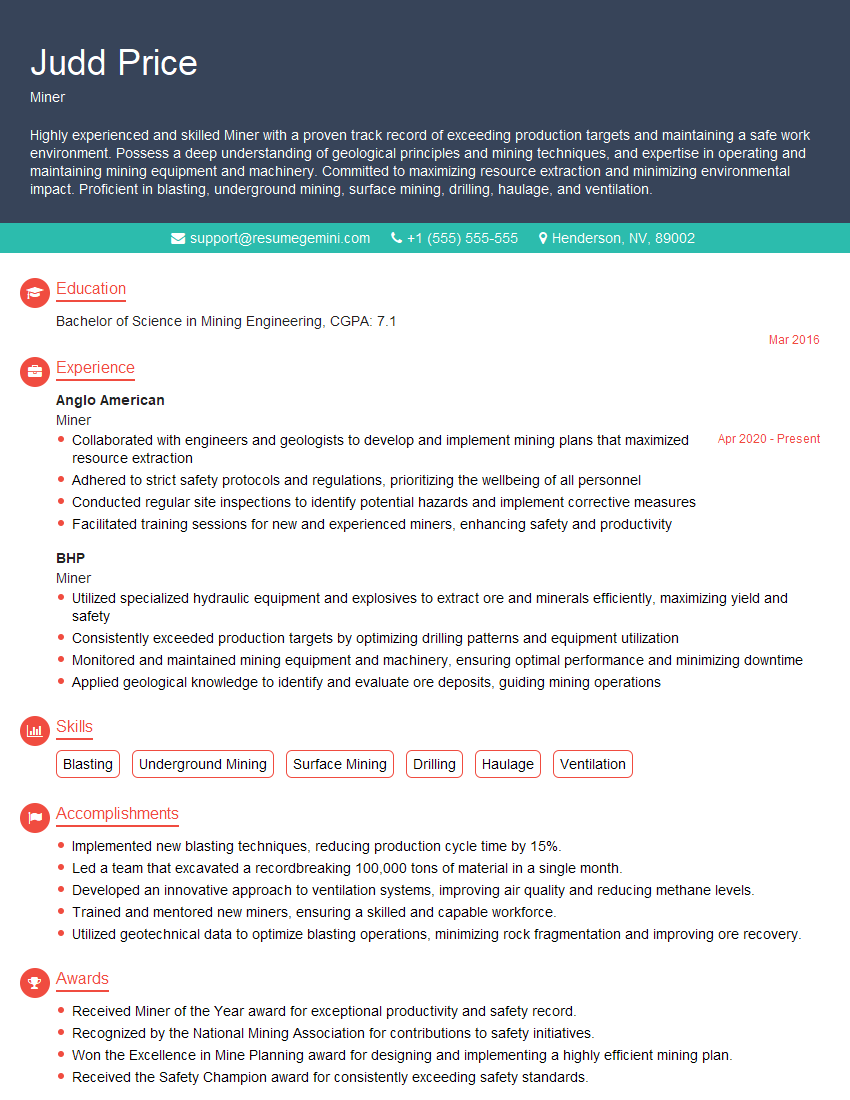Every successful interview starts with knowing what to expect. In this blog, we’ll take you through the top Outdoor Labor interview questions, breaking them down with expert tips to help you deliver impactful answers. Step into your next interview fully prepared and ready to succeed.
Questions Asked in Outdoor Labor Interview
Q 1. Describe your experience with operating power tools.
Throughout my career in outdoor labor, I’ve extensively used a wide range of power tools. This includes chainsaws (both gas and electric), string trimmers, leaf blowers, hedge trimmers, and various types of drills and saws used for fence construction and other projects. I’m proficient in their safe operation and maintenance, understanding the importance of regular sharpening and lubrication for optimal performance and longevity. For example, when using a chainsaw, I always ensure the chain is properly tensioned and lubricated, and I regularly inspect it for damage. With string trimmers, I understand the importance of using the correct line type and ensuring the head is correctly assembled to avoid kickbacks. My experience extends to both the practical application and the theoretical understanding of their mechanics, allowing me to troubleshoot and resolve minor issues independently.
Q 2. What safety measures do you prioritize when working with heavy machinery?
Safety is paramount when operating heavy machinery. My approach is multifaceted. Firstly, I always conduct a thorough pre-operational inspection. This includes checking fluid levels (oil, gas, hydraulic fluids), inspecting for any damage or loose parts, and ensuring all safety guards are in place and functioning correctly. Secondly, I wear the appropriate personal protective equipment (PPE), which can include safety glasses, hearing protection, steel-toed boots, gloves, and a hard hat, depending on the task. Thirdly, I maintain a clear workspace, free of obstructions and ensuring ample space for maneuverability. Finally, I strictly adhere to manufacturer’s instructions and any site-specific safety regulations. For instance, before operating a skid steer loader, I’ll always check the surroundings for potential hazards like bystanders or overhead obstructions. I follow a checklist approach to minimise the possibility of an incident. I also understand the importance of regular maintenance and reporting any defects immediately. Think of it like this: preventative maintenance is like regular car servicing; it’s far cheaper and safer than dealing with unexpected breakdowns.
Q 3. How do you handle physically demanding tasks in various weather conditions?
Working outdoors exposes you to a wide range of weather conditions. My strategy for handling physically demanding tasks in various weather involves adapting my approach and prioritizing safety. In extreme heat, I take more frequent breaks, hydrate constantly, and wear lightweight, breathable clothing. I’ll also adjust my work schedule to avoid the hottest part of the day if possible. In cold weather, I wear layers of warm clothing, including thermal underwear, ensuring my extremities are protected. I prioritize staying dry, as wet clothing rapidly lowers body temperature. I also pace myself and take extra breaks to avoid exhaustion. Remember, physical demands increase exponentially in extreme weather, so understanding pacing and adaptation is crucial. I’ve personally experienced working through both intense heat and freezing conditions, learning to listen to my body and recognizing the signs of heat stroke or hypothermia. This is non-negotiable.
Q 4. Explain your experience with different types of landscaping equipment.
My experience with landscaping equipment is extensive and encompasses a broad spectrum of machinery and tools. I’m proficient with various mowers (rotary, reel, zero-turn radius), edgers, cultivators, tillers, and aerators. I understand the principles of their operation and maintenance, including blade sharpening, filter cleaning, and routine lubrication. I’ve used both gas-powered and electric equipment, appreciating the advantages and disadvantages of each. For example, while gas-powered equipment is generally more powerful, electric options are often quieter and more environmentally friendly. My experience also extends to using specialized equipment like sod cutters and stump grinders when necessary. Choosing the appropriate equipment for the task is key, and it’s a skill developed through experience and a solid understanding of the tools’ capabilities.
Q 5. Describe your experience with soil preparation and planting techniques.
Soil preparation and planting are fundamental aspects of landscaping. I’m experienced in various techniques, beginning with assessing the soil’s composition and drainage. This involves testing the pH and amending the soil with compost, peat moss, or other organic matter to improve its structure and fertility as needed. I understand the importance of proper tilling or loosening of the soil to create a suitable environment for root growth. My planting techniques include proper spacing, depth, and watering. I’m also familiar with different planting methods, such as direct sowing, transplanting, and using starter cells. I’ve successfully planted a variety of species, from shrubs and trees to flowers and ground cover, and have dealt with a variety of soil types. Each planting requires specific adjustments according to soil conditions and the plant type. For instance, planting a large tree versus transplanting small herbs requires entirely different equipment and techniques.
Q 6. How do you identify and address potential safety hazards on a worksite?
Identifying and addressing safety hazards is a continuous process. My approach involves conducting regular site inspections, paying close attention to potential tripping hazards, uneven terrain, exposed utilities, and the presence of dangerous materials (e.g., chemicals, sharp objects). I assess the weather conditions and their potential impact on safety. I ensure proper signage and communication are in place to alert others to potential hazards. If I identify a hazard, I take immediate action to mitigate the risk. This could involve removing the hazard, putting up warning signs, or stopping work until the hazard is addressed. For example, if I find a damaged power cord, I immediately report it and ensure it is replaced before any work resumes. I see safety as a shared responsibility, and I actively participate in discussions regarding workplace safety to improve overall practices.
Q 7. What is your experience with irrigation systems?
My experience with irrigation systems includes installing, maintaining, and troubleshooting drip irrigation, sprinkler systems, and soaker hoses. I understand the principles of water conservation and efficient water distribution. I’m familiar with different types of emitters, valves, and controllers. I can identify leaks, clogs, and other malfunctions. My experience also includes working with timers and rain sensors to optimize watering schedules. For example, I’ve installed drip irrigation systems for flowerbeds, carefully planning the emitter placement and water pressure to ensure even distribution. Understanding the principles of water pressure, system layout, and potential problems like low water pressure or damaged piping is essential for maintaining efficient and effective irrigation.
Q 8. How do you manage your time effectively on large projects?
Managing time effectively on large outdoor labor projects relies on meticulous planning and a flexible approach. I start by breaking down the project into smaller, manageable tasks. This involves creating a detailed timeline, considering potential delays, and assigning realistic deadlines to each task. For example, on a recent landscaping project involving a large retaining wall, I first scheduled the excavation, then the foundation work, followed by the wall construction itself. Each stage had its own sub-tasks and timeline. I use project management tools like checklists and scheduling apps to track progress and ensure everything stays on schedule. Crucially, I remain adaptable. Unexpected weather, material delays, or equipment malfunctions can occur, so I build buffer time into my schedule and prioritize tasks based on urgency and dependencies. Regular progress meetings with the team also keep everyone aligned and address potential issues proactively.
Q 9. Explain your experience with pesticide application and safety protocols.
My experience with pesticide application is extensive and always prioritizes safety. I’m licensed and certified in the safe handling and application of various pesticides, adhering strictly to label instructions and local regulations. This includes understanding the specific toxicity levels, appropriate personal protective equipment (PPE), and the correct application methods for different pests and environments. For example, when dealing with termites, I would use a termiticide with the appropriate application method, following all safety guidelines, including wearing respirators and protective clothing. After application, proper disposal of containers and leftover chemicals is crucial. Safety protocols are paramount; I always conduct thorough site assessments before application, ensuring no non-target organisms are affected. Post-application, I clearly communicate potential hazards to clients and staff, providing instructions on re-entry times and safety measures. My commitment to safety includes regular training updates on the latest pesticide handling techniques and regulations.
Q 10. Describe your experience with tree pruning and removal techniques.
Tree pruning and removal demand a blend of skill and safety awareness. I’m proficient in various pruning techniques, from crown reduction to thinning, always employing the three-cut method to avoid bark stripping and damage. Different pruning methods are used depending on the tree species, its health, and the desired outcome. For example, I’d use a different approach for pruning a fruit tree to maximize yield compared to pruning a large shade tree for structural integrity. When removing a tree, safety is paramount. I use a combination of climbing techniques and ground-based methods, depending on the size and location of the tree. This involves assessing the tree’s condition, identifying potential hazards, and employing proper rigging techniques to ensure controlled felling. We use specialized equipment, including chainsaws, ropes, and winches, and always follow safety regulations like clearing the area and establishing a safety zone. Before any work commences, I complete a detailed risk assessment for every tree removal, outlining the steps needed for a safe and efficient job.
Q 11. How do you handle working independently versus as part of a team?
I’m comfortable working both independently and as part of a team. Independent work requires self-discipline, strong organizational skills, and the ability to problem-solve effectively on my own. For example, when conducting routine lawn maintenance for a client, I manage my time independently and complete the tasks efficiently, prioritizing work based on the property’s needs. However, when it comes to larger projects like a complex landscaping design or a significant tree removal, teamwork is essential. I readily contribute my expertise and collaborate effectively with colleagues, respecting individual roles and responsibilities. I value clear communication, ensuring everyone is informed and understands their contribution to the overall project goals. My experience working in teams has taught me the importance of coordinating efforts, sharing knowledge, and leveraging each team member’s unique skills to achieve optimal results. Ultimately, my adaptability allows me to thrive in both solo and collaborative environments.
Q 12. What is your experience with blueprint reading and following construction plans?
I possess considerable experience reading blueprints and following construction plans. My understanding extends beyond simply interpreting the drawings; I can identify potential conflicts, plan efficient workflows, and anticipate material needs. I’m familiar with various symbols and notations commonly used in construction blueprints, including those related to grading, drainage, and utilities. For instance, when working on a construction site involving a new patio, I carefully studied the blueprints to understand the grading requirements, ensuring proper drainage and avoiding potential issues. I also meticulously check for measurements, ensuring accuracy and consistency throughout the project. My ability to translate these plans into practical, on-site execution is critical in maintaining project accuracy and minimizing errors. This careful approach ensures the final product adheres to the design specifications and client expectations.
Q 13. How do you maintain the proper upkeep of equipment and tools?
Proper equipment and tool upkeep is crucial for safety and efficiency. My routine involves daily cleaning and inspection of all equipment, checking for damage, wear, and tear. I regularly lubricate moving parts, sharpen blades, and replace worn components as needed. Larger equipment, such as chainsaws and mowers, receives more in-depth maintenance, including regular servicing by qualified mechanics. I maintain detailed records of all maintenance activities, including dates, repairs, and parts replaced. This meticulous record-keeping allows for easy tracking of equipment lifespan and allows us to predict potential failures and prevent costly downtime. This proactive approach not only prolongs the life of our equipment but also significantly reduces the risk of accidents and injuries on the job site. Regular maintenance is an investment that pays off in terms of safety, productivity, and cost savings in the long run.
Q 14. What is your familiarity with different types of concrete and their applications?
My familiarity with different types of concrete and their applications is extensive. I understand the properties of various concrete mixes, including their compressive strength, setting time, and workability. This knowledge allows me to select the appropriate type of concrete for specific applications. For instance, I’d choose high-strength concrete for a foundation, while a rapid-setting mix might be ideal for smaller repairs. I understand the importance of proper mixing and placement techniques to ensure the concrete achieves its desired strength and durability. I am experienced in working with different admixtures, such as air-entraining agents and water reducers, to modify the properties of the concrete for specific needs. My understanding extends to finishing techniques, including floating, troweling, and brooming, to achieve various surface textures and finishes. This diverse knowledge allows me to effectively and efficiently use concrete in a wide range of projects.
Q 15. How do you adapt to changing weather conditions and job requirements?
Adapting to changing weather conditions and job requirements in outdoor labor is paramount for safety and productivity. It’s not just about putting on a rain jacket; it’s about a proactive, layered approach.
- Planning and Preparation: Before starting any job, I always check the forecast and plan accordingly. This includes selecting appropriate clothing and equipment. For example, if rain is predicted, I’ll bring waterproof gear and ensure my tools are protected. If extreme heat is expected, I’ll schedule work for cooler parts of the day, increase hydration breaks, and wear appropriate sun protection.
- Flexibility and Problem-Solving: Unexpected weather changes are inevitable. If a sudden storm rolls in, I know to immediately seek shelter and secure equipment. I’m adept at quickly reassessing the job and prioritizing safety. For instance, if heavy rain makes a particular task impossible, I might switch to an indoor task or reschedule the affected work.
- Communication: Open communication with my supervisor and team is crucial. I promptly report any weather-related concerns or changes to the work schedule that might impact the project timeline or safety. This ensures everyone is informed and working safely and efficiently.
- Experience Example: On one project, an unexpected heatwave significantly slowed down progress. By adjusting our work schedule, increasing water breaks, and implementing extra safety measures, we avoided heatstroke and still completed the project successfully, though slightly behind schedule.
Career Expert Tips:
- Ace those interviews! Prepare effectively by reviewing the Top 50 Most Common Interview Questions on ResumeGemini.
- Navigate your job search with confidence! Explore a wide range of Career Tips on ResumeGemini. Learn about common challenges and recommendations to overcome them.
- Craft the perfect resume! Master the Art of Resume Writing with ResumeGemini’s guide. Showcase your unique qualifications and achievements effectively.
- Don’t miss out on holiday savings! Build your dream resume with ResumeGemini’s ATS optimized templates.
Q 16. Describe your experience with working at heights.
Working at heights requires meticulous adherence to safety protocols and a healthy respect for potential risks. My experience includes extensive work on scaffolding, rooftops, and elevated platforms.
- Safety Training and Certifications: I hold current certifications in fall protection and working at heights, including training on proper harness use, anchor point selection, and rescue techniques. I always ensure my equipment is properly inspected before each job.
- Risk Assessment: Before commencing any work at heights, I conduct a thorough risk assessment, identifying potential hazards and planning mitigations. This may involve establishing secure anchor points, using guardrails, and employing proper fall arrest systems.
- Equipment Proficiency: I’m proficient in using various fall protection equipment, including harnesses, lanyards, lifelines, and safety nets. I understand the importance of proper equipment selection based on the specific task and environment.
- Experience Example: During a roofing project, I identified a weak point in the scaffolding. By reporting this immediately and collaborating with the team, we corrected the issue, preventing a potentially serious accident.
Q 17. What is your experience with trench safety procedures?
Trench safety is non-negotiable. My experience encompasses all aspects of safe trenching and excavation, from planning and inspection to emergency response.
- OSHA Compliance: I’m thoroughly familiar with OSHA regulations regarding trench safety (29 CFR 1926 Subpart P). This includes understanding requirements for shoring, sloping, and benching.
- Inspection and Monitoring: Before entering a trench, I always inspect it for hazards like unstable soil, standing water, or the presence of underground utilities. I understand the importance of regular inspections throughout the project.
- Emergency Procedures: I know how to recognize signs of a trench collapse and what to do in such a situation. This includes knowing how to safely evacuate the trench and alerting emergency services.
- Experience Example: On a recent project, we discovered an unexpected underground gas line while digging a trench. I immediately stopped work, contacted the utility company, and ensured everyone was safely away from the area before work resumed.
Q 18. How do you handle unexpected delays or challenges on a project?
Unexpected delays and challenges are common in outdoor labor. My approach focuses on proactive problem-solving and clear communication.
- Problem Identification and Analysis: When a delay occurs, my first step is to identify the root cause. This could range from equipment malfunction to unforeseen weather conditions. I then analyze the impact of the delay on the project timeline and budget.
- Solution Development: Once I’ve identified the problem, I develop potential solutions. This might involve adjusting the work schedule, requesting additional resources, or finding alternative methods to complete the task.
- Communication and Collaboration: I keep my supervisor and team updated throughout the process. Open communication ensures everyone is aware of the situation and can contribute to finding a solution.
- Experience Example: During a road construction project, a heavy rain storm caused a significant delay. I worked with the team to reroute traffic and prioritize tasks that weren’t weather-dependent, minimizing the overall impact on the project timeline.
Q 19. Describe your experience with first aid and emergency procedures.
I possess current first aid and CPR certifications, and am trained in responding to various workplace emergencies.
- First Aid and CPR: I’m confident in providing basic first aid, including wound care, treating burns, and administering CPR. I know how to assess injuries and prioritize treatment.
- Emergency Procedures: I’m familiar with workplace emergency procedures, including evacuation plans, reporting procedures for accidents, and contacting emergency medical services.
- Hazard Recognition and Prevention: A large part of emergency response is hazard recognition and prevention. I proactively identify potential risks and implement measures to minimize their likelihood.
- Experience Example: During a tree-felling operation, a colleague suffered a minor cut. I promptly administered first aid, cleaned the wound, and applied a bandage. I also documented the incident, per company policy.
Q 20. What is your proficiency in using GPS and surveying equipment?
My proficiency with GPS and surveying equipment is a key asset in outdoor labor, ensuring accurate measurements and efficient project planning.
- GPS Operation: I’m experienced in using various GPS receivers for precise location mapping and data collection. I understand the importance of signal quality and error correction.
- Surveying Equipment: I’m proficient in using levels, theodolites, and total stations for accurate measurements and site surveying. I understand basic surveying principles and techniques.
- Data Interpretation and Management: I can interpret data from GPS and surveying equipment to create accurate maps and plans. I am familiar with using software for data processing and analysis.
- Experience Example: On a recent land-clearing project, I used a GPS receiver to precisely map the boundaries of the work area, ensuring we stayed within the designated limits and avoided unintended damage.
Q 21. How do you maintain accurate records of materials and labor hours?
Accurate record-keeping is essential for project management and billing. I use a combination of digital and manual methods to maintain detailed records.
- Time Tracking: I meticulously track my work hours using timesheets, ensuring accurate accounting of labor costs. I utilize both paper and digital timesheet systems.
- Material Tracking: I maintain precise records of materials used, including quantities, costs, and suppliers. I regularly compare the actual materials used with the initial estimates.
- Digital Documentation: I use digital tools such as spreadsheets and project management software to organize data and generate reports.
- Regular Audits: I regularly audit my records to ensure accuracy and identify any discrepancies.
- Experience Example: On a large landscaping project, I meticulously tracked the quantities of materials used – from mulch and plants to gravel and pavers – and compared them to our initial budget, ensuring cost-effectiveness and minimizing waste.
Q 22. Describe your understanding of environmental regulations and best practices.
Environmental regulations and best practices are paramount in outdoor labor. My understanding encompasses a broad range, from local ordinances regarding waste disposal and stormwater management to federal regulations concerning endangered species protection and the Clean Water Act. I’m familiar with the importance of erosion control techniques like silt fencing and using appropriate vegetation to stabilize slopes. For example, on a recent project involving trail construction in a sensitive wetland area, we meticulously followed the Army Corps of Engineers guidelines for permit acquisition and mitigation. We implemented measures to minimize habitat disturbance, using environmentally friendly materials and adhering to specific timing restrictions to avoid nesting seasons. Best practices also extend to minimizing fuel consumption through efficient equipment use and vehicle scheduling and promoting responsible chemical use, including proper storage and disposal of pesticides and herbicides.
- Understanding and adhering to all relevant permits and licenses.
- Implementing erosion and sediment control measures.
- Proper waste disposal and recycling practices.
- Minimizing water usage and protecting water quality.
- Protecting wildlife habitats and endangered species.
Q 23. Explain your experience with different types of fencing materials and installation techniques.
My experience with fencing spans various materials and installation methods. I’ve worked extensively with wood, vinyl, chain link, and wrought iron fencing. Wood fencing, while aesthetically pleasing, requires regular maintenance and is susceptible to rot and insect damage. Vinyl is low-maintenance but can be more expensive upfront. Chain link is robust and cost-effective, ideal for large areas or security applications. Wrought iron offers superior durability and elegance, but is the most costly option and requires specialized installation skills. Installation techniques vary depending on the material and terrain. For example, installing a wood fence requires digging post holes to a precise depth, setting posts using concrete, and attaching the rails and panels. Chain link necessitates tensioning the wire mesh to ensure stability. Proper grading and drainage around the fence base are crucial for longevity, regardless of the material. I’ve personally supervised projects involving hundreds of linear feet of fencing, successfully managing budgets and timelines, while ensuring structural integrity and adherence to client specifications.
Q 24. What is your experience with managing a team and delegating tasks?
Team management is a cornerstone of my experience. I believe in fostering a collaborative and positive work environment. My approach involves clear communication, delegation based on individual strengths and skills, and regular performance feedback. For instance, on a recent landscaping project, I divided the team into smaller groups responsible for specific tasks—planting, hardscaping, irrigation installation—based on their expertise. I provided each team leader with detailed instructions and a clear timeline. Regular check-ins allowed for timely problem-solving and adjustments to the schedule as needed. This strategy improved efficiency and boosted team morale, resulting in the project’s completion ahead of schedule and within budget. I’m adept at motivating team members, resolving conflicts, and ensuring every team member understands their role and contribution to the overall goal.
Q 25. How do you handle customer interactions and feedback?
Handling customer interactions is crucial. I prioritize active listening and clear communication to understand their needs and expectations. I believe in maintaining professionalism and empathy, even when faced with difficult situations. For instance, when a client expressed concern over a slight delay in a project due to unforeseen weather conditions, I proactively communicated the situation, offered a revised timeline, and provided updates regularly. I actively solicited their feedback throughout the project, ensuring they felt heard and valued. Addressing concerns promptly and transparently builds trust and maintains positive client relationships. Constructive feedback is vital for continuous improvement, and I use it to refine my approach and ensure client satisfaction.
Q 26. What are your salary expectations?
My salary expectations are commensurate with my experience and skills, and I am open to discussing a competitive compensation package based on the specific requirements and responsibilities of the role.
Q 27. What are your long-term career goals within this field?
My long-term career goals involve progressing to a management position where I can leverage my skills and experience to oversee larger-scale projects and mentor other professionals in the outdoor labor field. I am interested in gaining experience in project management, potentially seeking relevant certifications to enhance my expertise. I also aim to stay abreast of the latest industry trends, technologies, and best practices, ensuring I remain a valuable asset to any organization.
Q 28. Describe your experience with conflict resolution on a job site.
Conflict resolution is an essential part of outdoor labor. I have successfully resolved several conflicts on job sites. My approach involves fostering open communication, remaining impartial, and finding mutually agreeable solutions. For instance, a disagreement arose between two team members regarding the best approach to a particular landscaping task. Rather than taking sides, I facilitated a discussion where both members could express their views and concerns. We collaboratively identified the pros and cons of each approach and arrived at a compromise that utilized the best aspects of both. Focusing on the shared goal—completing the project to the client’s satisfaction—helped to de-escalate the situation and ultimately strengthen team cohesion.
Key Topics to Learn for Your Outdoor Labor Interview
- Safety Procedures and Regulations: Understanding and adhering to OSHA regulations, safe equipment operation, hazard identification, and emergency response protocols are paramount in outdoor labor. Practical application includes demonstrating knowledge of specific safety equipment and procedures relevant to the job description (e.g., fall protection, PPE use).
- Physical Stamina and Endurance: Outdoor labor demands physical strength and resilience. Be prepared to discuss your experience with physically demanding tasks and your strategies for maintaining stamina and preventing injuries. Consider highlighting any relevant certifications or training (e.g., First Aid, CPR).
- Teamwork and Communication: Many outdoor labor roles involve collaborative efforts. Discuss your ability to work effectively within a team, communicate clearly and respectfully, and contribute to a positive work environment. Examples might include experiences working on group projects or in team-based settings.
- Environmental Awareness and Stewardship: Depending on the specific role, demonstrating awareness of environmental concerns and best practices for sustainable work is crucial. This could involve knowledge of responsible waste disposal, conservation techniques, or awareness of local flora and fauna.
- Problem-Solving and Adaptability: Outdoor work often presents unexpected challenges. Be ready to discuss your problem-solving skills and ability to adapt to changing conditions, weather, or unforeseen circumstances. Use the STAR method (Situation, Task, Action, Result) to structure your answers.
- Specific Job Skills & Equipment Knowledge: Research the specific job description thoroughly and prepare to discuss your proficiency with any relevant tools, machinery, or techniques mentioned. This could include operating specific equipment, using hand tools effectively, or knowledge of specific materials.
Next Steps
Mastering the skills and knowledge related to outdoor labor opens doors to diverse and rewarding career paths, offering opportunities for advancement and specialization. To significantly boost your job prospects, creating a strong, ATS-friendly resume is vital. ResumeGemini is a trusted resource that can help you build a professional resume tailored to highlight your unique skills and experience. We provide examples of resumes specifically designed for the outdoor labor sector to help you get started. Take advantage of these resources to present yourself as the ideal candidate!
Explore more articles
Users Rating of Our Blogs
Share Your Experience
We value your feedback! Please rate our content and share your thoughts (optional).
What Readers Say About Our Blog
Hello,
We found issues with your domain’s email setup that may be sending your messages to spam or blocking them completely. InboxShield Mini shows you how to fix it in minutes — no tech skills required.
Scan your domain now for details: https://inboxshield-mini.com/
— Adam @ InboxShield Mini
Reply STOP to unsubscribe
Hi, are you owner of interviewgemini.com? What if I told you I could help you find extra time in your schedule, reconnect with leads you didn’t even realize you missed, and bring in more “I want to work with you” conversations, without increasing your ad spend or hiring a full-time employee?
All with a flexible, budget-friendly service that could easily pay for itself. Sounds good?
Would it be nice to jump on a quick 10-minute call so I can show you exactly how we make this work?
Best,
Hapei
Marketing Director
Hey, I know you’re the owner of interviewgemini.com. I’ll be quick.
Fundraising for your business is tough and time-consuming. We make it easier by guaranteeing two private investor meetings each month, for six months. No demos, no pitch events – just direct introductions to active investors matched to your startup.
If youR17;re raising, this could help you build real momentum. Want me to send more info?
Hi, I represent an SEO company that specialises in getting you AI citations and higher rankings on Google. I’d like to offer you a 100% free SEO audit for your website. Would you be interested?
Hi, I represent an SEO company that specialises in getting you AI citations and higher rankings on Google. I’d like to offer you a 100% free SEO audit for your website. Would you be interested?
good

